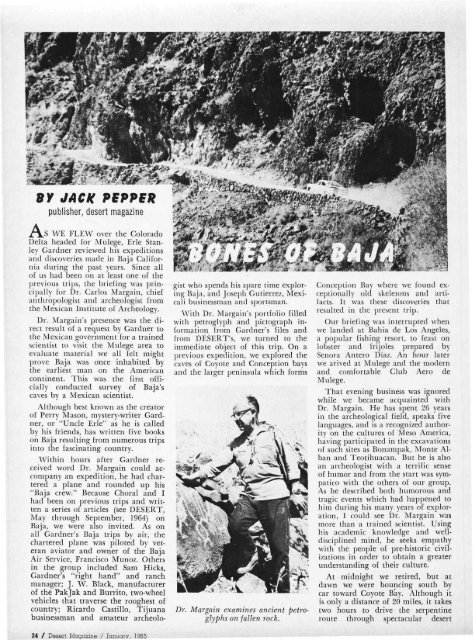desert magazine's special attractions - Desert Magazine of the ...
desert magazine's special attractions - Desert Magazine of the ...
desert magazine's special attractions - Desert Magazine of the ...
You also want an ePaper? Increase the reach of your titles
YUMPU automatically turns print PDFs into web optimized ePapers that Google loves.
BY JACK PEPPER<br />
publisher, <strong>desert</strong> magazine<br />
A WE FLEW over <strong>the</strong> Colorado<br />
Delta headed for Mulege, Erie Stanley<br />
Gardner reviewed his expeditions<br />
and discoveries made in Baja California<br />
during <strong>the</strong> past years. Since all<br />
<strong>of</strong> us had been on at least one <strong>of</strong> <strong>the</strong><br />
previous trips, <strong>the</strong> briefing was principally<br />
for Dr. Carlos Margain, chief<br />
anthropologist and archeologist from<br />
<strong>the</strong> Mexican Institute <strong>of</strong> Archeology.<br />
Dr. Margain's presence was <strong>the</strong> direct<br />
result <strong>of</strong> a request by Gardner to<br />
<strong>the</strong> Mexican government for a trained<br />
scientist to visit <strong>the</strong> Mulege area to<br />
evaluate material we all felt might<br />
prove Baja was once inhabited by<br />
<strong>the</strong> earliest man on <strong>the</strong> American<br />
continent. This was <strong>the</strong> first <strong>of</strong>ficially<br />
conducted survey <strong>of</strong> Baja's<br />
caves by a Mexican scientist.<br />
Although best known as <strong>the</strong> creator<br />
<strong>of</strong> Perry Mason, mystery-writer Gardner,<br />
or "Uncle Erie" as he is called<br />
by his friends, has written five books<br />
on Baja resulting from numerous trips<br />
into <strong>the</strong> fascinating country.<br />
Within hours after Gardner received<br />
word Dr. Margain could accompany<br />
an expedition, he had chartered<br />
a plane and rounded up his<br />
"Baja crew." Because Choral and I<br />
had been on previous trips and written<br />
a series <strong>of</strong> articles (see DESERT,<br />
May through September, 1964) on<br />
Baja, we were also invited. As on<br />
all Gardner's Baja trips by air, <strong>the</strong><br />
chartered plane was piloted by veteran<br />
aviator and owner <strong>of</strong> <strong>the</strong> Baja<br />
Air Service, Francisco Munoz. O<strong>the</strong>rs<br />
in <strong>the</strong> group included Sam Hicks,<br />
Gardner's "right hand" and ranch<br />
manager; J. W. Black, manufacturer<br />
<strong>of</strong> <strong>the</strong> Pakjak and Burrito, two-wheel<br />
vehicles that traverse <strong>the</strong> roughest <strong>of</strong><br />
country; Ricardo Castillo, Tijuana<br />
businessman and amateur archeolo-<br />
24 / <strong>Desert</strong> <strong>Magazine</strong> / January, 1965<br />
gist who spends his spare time exploring<br />
Baja, and Joseph Gutierrez, Mexicali<br />
businessman and sportsman.<br />
With Dr. Margain's portfolio filled<br />
with petroglyph and pictograph information<br />
from Gardner's files and<br />
from DESERT'S, we turned to <strong>the</strong><br />
immediate object <strong>of</strong> this trip. On a<br />
previous expedition, we explored <strong>the</strong><br />
caves <strong>of</strong> Coyote and Conception bays<br />
and <strong>the</strong> larger peninsula which forms<br />
Dr. Margain examines ancient<br />
glyphs on fallen rock.<br />
Conception Bay where we found exceptionally<br />
old skeletons and artifacts.<br />
It was <strong>the</strong>se discoveries that<br />
resulted in <strong>the</strong> present trip.<br />
Our briefing was interrupted when<br />
we landed at Bahia de Los Angeles,<br />
a popular fishing resort, to feast on<br />
lobster and frijoles prepared by<br />
Senora Antero Diaz. An hour later<br />
we arived at Mulege and <strong>the</strong> modern<br />
and comfortable Club Aero de<br />
Mulege.<br />
That evening business was ignored<br />
while we became acquainted with<br />
Dr. Margain. He has spent 26 years<br />
in <strong>the</strong> archeological field, speaks five<br />
languages, and is a recognized authority<br />
on <strong>the</strong> cultures <strong>of</strong> Meso America,<br />
having participated in <strong>the</strong> excavations<br />
<strong>of</strong> such sites as Bonampak, Monte Alban<br />
and Teotihuacan. But he is also<br />
an archeologist with a terrific sense<br />
<strong>of</strong> humor and from <strong>the</strong> start was sympatico<br />
with <strong>the</strong> o<strong>the</strong>rs <strong>of</strong> our group.<br />
As he described both humorous and<br />
tragic events which had happened to<br />
him during his many years <strong>of</strong> exploration,<br />
I could see Dr. Margain was<br />
more than a trained scientist. Using<br />
his academic knowledge and welldisciplined<br />
mind, he seeks empathy<br />
with <strong>the</strong> people <strong>of</strong> pre-historic civilizations<br />
in order to obtain a greater<br />
understanding <strong>of</strong> <strong>the</strong>ir culture.<br />
At midnight we retired, but at<br />
dawn we were bouncing south by<br />
car toward Coyote Bay. Although it<br />
is only a distance <strong>of</strong> 20 miles, it takes<br />
two hours to drive <strong>the</strong> serpentine<br />
route through spectacular <strong>desert</strong>

















